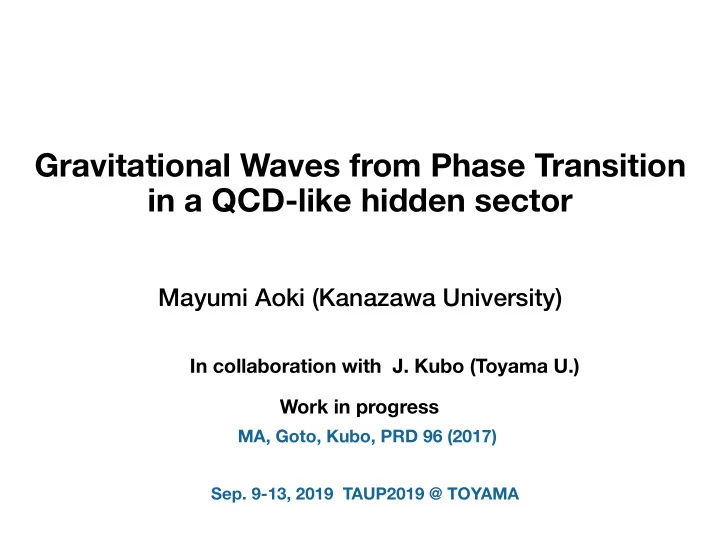

Gravitational Waves from Phase Transition in a QCD-like hidden sector Mayumi Aoki (Kanazawa University) In collaboration with J. Kubo (Toyama U.) Work in progress MA, Goto, Kubo, PRD 96 (2017) Sep. 9-13, 2019 TAUP2019 @ TOYAMA
Introduction ❖ The Higgs boson was discovered at the LHC in 2012. → All particles in the SM had been discovered. ❖ The observation is in agreement with the SM. No signal for BSM at the LHC after the Higgs boson discovery. ❖ LIGO had made the first observation of the GW in 2015. → A new way to study astrophysical phenomena. ❖ Phenomena in the early universe can also be probed by the GW. 2
Origin of Mass ❖ The Higgs boson is tightly connected with the mechanism for generating mass in the SM. ✤ Spontaneous Electroweak Symmetry Breaking V SM = m 2 H H † H + λ H ( H † H ) 2 SU(2) L × U(1) Y → U(1) em → The SM particles get their masses. h h i = 246 GeV 3
Origin of Mass ❖ The Higgs boson is tightly connected with the mechanism for generating mass in the SM. ✤ Spontaneous Electroweak Symmetry Breaking V SM = m 2 H H † H + λ H ( H † H ) 2 SU(2) L × U(1) Y → U(1) em → The SM particles get their masses. h h i = 246 GeV ❖ Mass of the nucleon: 2% + 98% Higgs EWSB QCD Dynamical chiral symmetry h ¯ qq i breaking (D χ SB) 3
Origin of Mass ❖ The Higgs boson is tightly connected with the mechanism for generating mass in the SM. ✤ Spontaneous Electroweak Symmetry Breaking V SM = m 2 H H † H + λ H ( H † H ) 2 SU(2) L × U(1) Y → U(1) em → The SM particles get their masses. h h i = 246 GeV ❖ Mass of the nucleon: 2% + 98% Higgs EWSB QCD Dynamical chiral symmetry h ¯ qq i breaking (D χ SB) ❖ The EW and QCD phase transitions are crossovers within the SM. They cannot produce the GW background. ❖ In the BSM, observable GW signals associated with a symmetry breaking may be produced and tested. 3
× A Classical Scale Invariance Model ❖ We study the testability of the GW background produced by the hidden chiral phase transition in the classical scale invariance model. V SM = m 2 H H † H + λ H ( H † H ) 2 ❖ The classical scale invariance is one of candidates for the solution of hierarchy problem. 4
× A Classical Scale Invariance Model ❖ We study the testability of the GW background produced by the hidden chiral phase transition in the classical scale invariance model. V SM = m 2 H H † H + λ H ( H † H ) 2 ❖ The classical scale invariance is one of candidates for the solution of hierarchy problem. ❖ We consider a classical scale invariance model with the strongly interacting SU(3) Hidden sector by Holthausen, Kubo, Lim, Lindner, JHEP 1312 (2013). ✤ The chiral phase transition in the hidden sector is of first order. We study the testability of the GW background produced by the phase transition in the hidden sector. 4
Recommend
More recommend